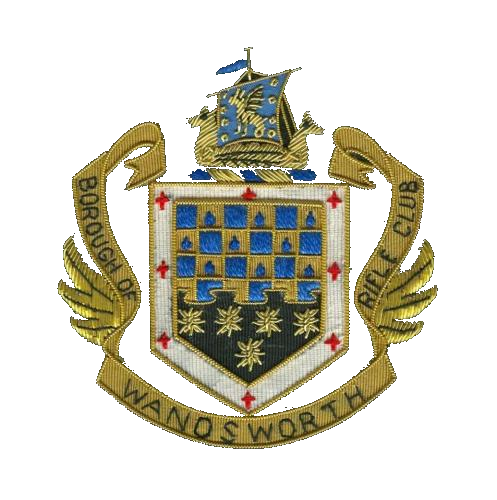Here follows a reprint from “The Rifleman” in February 1937 which featured an article on The Borough of Wandsworth Rifle Club. The reprint is pasted in its entirety although the pictures have been added for the purposes of this website.
The Borough of Wandsworth Rifle Club by sheer merit has won an honoured position in the world of rifle shooting. It claims to be the oldest of the two thousand two hundred organisations affiliated to the S.M.R.C., and even the most modest of its members is in a position to boast that it is certainly one of the most successful clubs with that august body.
Thirty- four years of uninterrupted and progressive existence speaks eloquently of careful and painstaking management, but undoubtedly the keynote of success has been the unbounded enthusiasm which has been so marked a characteristic from its inception way back in 1903 when it was christened the Earlsfield and District Rifle Club.
The group of buildings and outdoor ranges on the right bank of the River Wandle was not then in existence. Only a small scale open-air range was available at Earlsfield, but a far-seeing Borough Council enabled the good work to be continued in winter by a ready permission for the erection of a range in the bed of the public baths.
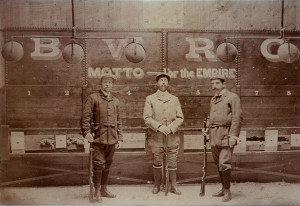
The club, however, was not born with the proverbial silver spoon in its mouth, and the commodious premises and workmanlike layout of ranges which it has enjoyed as headquarters for so many years now are the result of unstinted endeavour and perseverance of those who have guided its fortunes for more than a quarter of a century.
Many people have contributed to the club’s success by manual labour or financial assistance, but the real driving force during the greater part of its existence has been provided by that indefatigable hon. secretary and treasurer, Ernest H. Bailey.
Immediately after being elected to the secretariate thirty years ago, Ernest demonstrated that the way to spell his name was “earnest.” A ready smile proved an irresistible recruiting agent when volunteers were wanted to man picks and shovels or to haul heavy sleepers into position. Those huge pieces of wood for the butts, by the way, were the only form of “sleepers” ever encouraged at this famous rendezvous of rifle shoots.
Bailey not only proved his worth with the pen and in obtaining the pence, but he rapidly became a real asset as a marksman.
Twice he has won the Club Championship and three times each the Samuel Samuel, Lorden and Mons Cups, while on four occasions he has captained the Wandsworth team in the Inter-Borough Competition.
In other directions he threw himself wholeheartedly into the promotion of rifle shooting. He was actively associated with the “Roberts Cup” (miniature) competition, and the League of Civilian Rifle Clubs, being the first chairman of the latter.
With nearly thirty years continuous service to his credit, he can probably lay undisputed claim to being the longest serving hon. Secretary of a rifle club. He combines with the office that of treasurer, and despite financial stress prevalent since the war has kept the club in a sound position.
“For The Empire” is the motto of the Borough of Wandsworth Rifle Club. During the Great War it gave full justification for the use of the slogan. Ernest Bailey and “Bob” Harker – who later captained a company of the East Surrey Regt. In the front line- founded the Wandsworth Civil Guard, subsequently known as the Wandsworth and Earlsfield Battalion of the Athletes Volunteer Force.
With its customary generosity the Borough of Wandsworth R.C. provided facilities for drill and rifle shooting, and in the course of the war some 2,000 men enrolled. Of these, a large number joined the regular forces and saw service on one or other of the fronts.
When it is recalled that over 300 members of the Borough Club joined up during the European conflagration, it will be readily accorded that the club lived up to its motto.
Delving back into the past, it is fitting to recall that the formation of the club in 1903 was chiefly brought about by the influence of Lieut.General Sir Frederick Lance, K.C.B., who was assisted by Mr. F. J. Liddington, when both were members of the Wandsworth Borough Council.
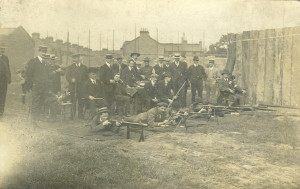
Seventy members signed along the dotted line at the initial meeting, public-spirited men contributed funds necessary for rifles and range equipment, and the Borough Fathers gave tangible proof of their approval of the scheme by loaning the baths free of charge.
About this time the Wandsworth Town Club and the Borough officers’ Club were in extremis, and a brainwave suggestion resulted in an amalgamation of these with the Earlsfield and District Club, by then a flourishing concern. Henceforth the combination of rifleman bore the title Borough of Wandsworth Rifle Club. The first chairman of the new organisation was Mr. Peter Dodd.
That was in 1904, and in the same year the Borough council granted a piece of land, nearly two acres in extent, at a nominal rental for the erection of an open range and a covered range.
The former, constructed of timber faced with iron plates 40 feet by 20 feet at two distances – 25 and 50 yards – was the work of the Committee and members of the Club, not one penny being spent on labour.
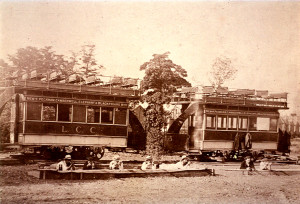
Two old tram-cars purchased for £4 10s. The two provided the Club’s Headquarters, for the purpose of holding Committee meetings and storing targets, etc., but in June, 1905, the club decided to construct a covered indoor range, and a local firm of builders was commissioned to carry out the work.
The building was completed in a satisfactory manner, and fitted with the (then) latest pattern N.R.A. range equipment, winding apparatus for changing the targets.
The opening ceremony was performed by Field Marshal Lord Roberts, supported by very many members of the Borough Council, and other public gentlemen.
In 1908 the Committee decided to extend the indoor range, and added a comfortable retiring room, fitted up with a full-size billiard table and refreshment bar. The work of erecting this extension was carried out by Mr. Andrew, again aided by voluntary labour. A few members provided the necessary funds for purchasing the billiard table under somewhat novel arrangements. Half the takings was given to the club, the other half being divided quarterly among those who provided the capital. When the club had accumulated sufficient money from their dividends they bought shares of the members at 10s. per share by ballot.
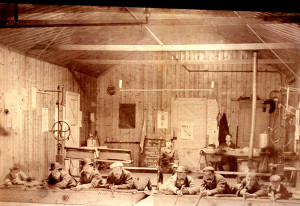
The table formed a good source of revenue to the club for a time, but after two or three winters it was found that the atmosphere was too damp for a perfect game of billiards – owing to the proximity of the Wandle, be it understood – and it was decided to sell the table and divide the cash received amongst those holding shares, and the club.
In 1912, it was resolved to move with the times and bring the club up to date by demolishing the existing outdoor 25 and 50 yards stop butts, and re-erecting 25, 50 and 100 yards ranges. In the face of a very small bank balance, the scheme was put forward and instead of being dismayed at the lack of the necessary funds for carrying out this project, the Hon. Secretary approached the Mayor of Wandsworth ( Sir Archibald D. Dawnay) and the Club’s President (Ald. James Wise, J.P., ex-Mayor of Wandsworth ) for some iron girders and railway sleepers.
When these materials were duly delivered then the enthusiastic members, “sans coats and waistcoats,” discharged the duties of navvies, carpenters and engineers, and by their labour saved the club the alternatives of either plunging heavily into debt or of suffering from want of facilities.
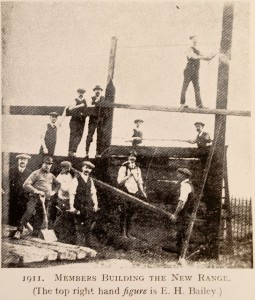
There are many things connected with the club of which the members are proud: The al fresco ranges, the special concrete firing point, and the hut on the outdoor firing point, all of which have been acquired without a penny being spent on labour. These butts have been met with the high approval of the War Office, and remarks to this effect appear on the club’s War Office safety certificate.
In September, 1906, Mr. A. Keen won the Lord Sudeley Trophy at the first London meeting at Ham and Petersham. A month later the then captain of the club, Mr. P. E. Kennedy, put forward a scheme to promote the sport of rifle shooting through the medium of The Rifleman by the formation of a Miniature League of Civilian Rifle Clubs. This was afterwards adopted.
The year 1907 was notable because Mr. Kensit-Styles, a member of the club, represented London in the Queen’s Cup when it was an individual competition, for the top scorer of each county to compete in the final shoulder-to-shoulder. On Easter Monday, 1911, at the open meeting at the Addiscombe Rifle Club’s range a team from the Borough of Wandsworth Rifle Club created a record for disc-breaking. They succeeded in breaking five one-inch discs in seven seconds with five shots at 50 yards. The winning team consisted of Messrs. H. J. Burt, J.P. Jarvis, M. Andrew and W. Emerton.
Three members of the club – Messrs. W. E. Pimm, J. F. Fleming and W. Kensit-Styles – were chosen in 1909 to represent England by the Olympic Committee at Olympia, and each of them succeeded in winning a gold medal. In May, 1910, Mr. W. E. Pimm capitained the English team which visited Roubaix to shoot a shoulder-to- shoulder match against France, and the bronze trophy reposes in the S.M.R.C. offices to this day.
The Hon. Secretary, assisted by Messrs. Allen and Roe formed a Boys’ Brigade at the club. That was in 1909.
The club had 34 entries in the Queen Alexandra Cup in 1910, and in that year was one of the founding clubs of the City of London Rifle League. It has continued an unbroken membership of this League up to the present moment, on many occasions reaching the final. The Hon. Secretary of the club was one of the first chairmen of the League. In 1912, Mr. H. J. Burt, another member of the club, was one of the English team which went to Kaknas, Stockholm, Olympia and won the bronze medal for third place.
The following are a few of the club teams’ and individual successes:-
- 1914 Bryant and May’s Challenge Cup. Ham and Petersham
- 1930 London Challenge Shield. National League, Division IV
- 1930 Heslop Challenge Shield. National League, Division V
- 1931 City of London Rifle League Challenge Cup
- 1931 Howard Challenge Cup. Hastings
- 1931 Patriotic Shield No.5 National League, Division II
- 1931 Patriotic Shield No.4 Hastings
- 1934 Lord Cheylesmore Challenge Trophy. Bisley
- 1930 Mr. N. C. Castle won the Manx Challenge Cup, and the Championship Gold Medal at Lowestoft
- 1934 Mr. R. H. Hore won the Lord Sudeley Trophy at Alexandra Palace, also the Manx Challenge Cup at the same meeting, Mr. N. C. Headland won the Ramsey Challenge Cup at Bisley
On many occasions the club has secured second and third place for team competitions at the Society’s open meetings, and in 1933 established a record still unbeaten in the national league – 1783 ex 1800, 25, 50 and 100 yards.
Many famous shooting men have enjoyed membership of this old established club, including Mr. Kensit-Styles, Messrs. P. Kennedy, King, Langley, H. J. Burt and, in more recent years, G. F. Booth, F. Harverson and P. G. Richardson.
The Great coster comedian, Gus Elen, was a member at one time, and a very enthusiastic one at that.
The club has been captained successively by W. E. Pimm, H. J. Roberts, P. E. Kennedy, A. E. Cooke, W.R. Wood, H. J. Burt, G. F. Booth, F. Harverson, C. R. Coen and for the last eight years, by N. C. Headland.
For the last 20 years the club has enjoyed the local Member of Parliament as its president, and every year since the foundation of the club, the Mayor of Wandsworth has during his mayoralty associated himself with it. In most cases his support has continued after his term of office. Sir John W, Lorden, J.P., when Mayor in 1904, to commemorate his year of office, presented the club with a handsome silver challenge cup for competition amongst the members, and has every year since the presentation given the winner each year a gold medal for the winner to commemorate his success.
